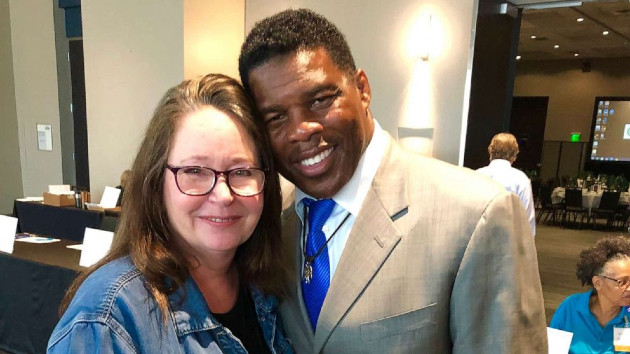
(NEW YORK) — A woman who accused Georgia Republican Senate nominee Herschel Walker of pressuring her into having an abortion defended her claims in an exclusive interview with ABC News, saying he is not fit for office and that “honesty matters.”
Walker has denied the allegations, which were first made at a press conference last week, dismissing the claims as “foolishness” while adding “this is all a lie, and I will not entertain any of it.”
The woman, whom ABC News agreed to call Jane Doe, told ABC News in her first on-camera interview that she decided to come forward after another woman made similar claims that Walker had also pressured her into having an abortion.
Speaking with Juju Chang, co-anchor of ABC News’ Nightline, the woman said that in 1993 she became pregnant amid a yearslong affair with Walker, saying they saw each other “several times a week, usually in the mornings” and that they were in love.
“[Walker] was very clear that he did not want me to have the child. And he said that because of his wife’s family and powerful people around him that I would not be safe and that the child would not be safe,” the woman said.
“I felt threatened and I thought I had no choice,” said the woman, who has come forward on camera for the first time since making her allegations public at a press conference last week with her attorney, Gloria Allred.
Responding to the ABC News interview, Walker issued a statement Tuesday saying, “This was a lie a week ago and it is a lie today. Seven days before an election, the Democrats trot out Gloria Allred and some woman I do not know. My opponents will do and say anything to win this election. The entire Democrat machine is coming after me and the people of Georgia. I am not intimidated. Once again, they messed with the wrong Georgian.”
In her interview with Chang, Jane Doe recalled initially going to a clinic to have an abortion before abruptly leaving after having a change of heart.
“I guess it is part of the procedure then that they did an ultrasound. And I saw the ultrasound and I couldn’t go through with it. So I left the clinic and went back home,” she said with emotion in her voice.
According to the woman, Walker then told her he would drive her to the clinic to have the procedure.
“He came to my house and picked me up and drove me to the clinic,” the woman recalled. “I went in alone and he waited in the car while I went in and had the procedure. And then I came out and he drove me to the drugstore, and then he took me home.”
Jane Doe said Walker gave her cash to pay for the abortion. She said she has no receipt for the payment or record of the procedure.
Walker, who is running against Democratic Sen. Raphael Warnock, is campaigning as a staunch anti-abortion-rights candidate.
According to Jane Doe, she maintained a friendly relationship with Walker for decades and last spoke with him by phone in March 2020.
Two women identified to ABC News as friends of Jane Doe by her lawyer Gloria Allred said that Jane Doe confided to them in the 1990s that she had a yearslong affair with Walker and that she became pregnant during that relationship.
Jane Doe said she last saw Walker at a mental health event in 2019.
“He gave — he hugged me, and was very happy to see me … He was very nice and cordial,” she said of their meeting in 2019.
One of the woman identified as a friend of Jane Doe’s said she was with her at the event and took a picture of her and Walker together, telling ABC News, “They embraced for a long time … they had clearly known each other for years and years.”
Jane Doe said she never brought up the abortion with Walker while they stayed in touch.
Walker previously denied an ex-girlfriend’s claim to various news outlets that he paid for her to have an abortion in 2009. That woman told The Daily Beast that she had documents supporting her allegation, including a receipt from an abortion clinic, a bank deposit receipt with an image of a $700 check that she said was signed by Walker sent within a week of the abortion, and also a “get well” card that she said was signed by Walker.
During an appearance last week on Fox News’ Special Report with Bret Baier, Walker issued blanket denials about the recent allegations made against him.
“Well, that’s a lie. And I’ve said that’s a lie and I hope people can see right now that Raphael Warnock and the Left would do whatever they can to win the seat,” Walker said. “I’ve said it once and I’ve moved on, my campaign moved on because we’re worried about what the Georgia people are talking about … I’ve said this a lie. I’ve moved on, and they want me to play these guessing games and all of this, but I’m not. I’m not into that. I’m into winning this great seat back for the great people of Georgia because that’s what this is about.”
Jane Doe told Chang that, following Walker’s denials, she now thinks he isn’t fit to be a U.S. senator.
Asked why, she said, “I think honesty matters.”
Copyright © 2022, ABC Audio. All rights reserved.









